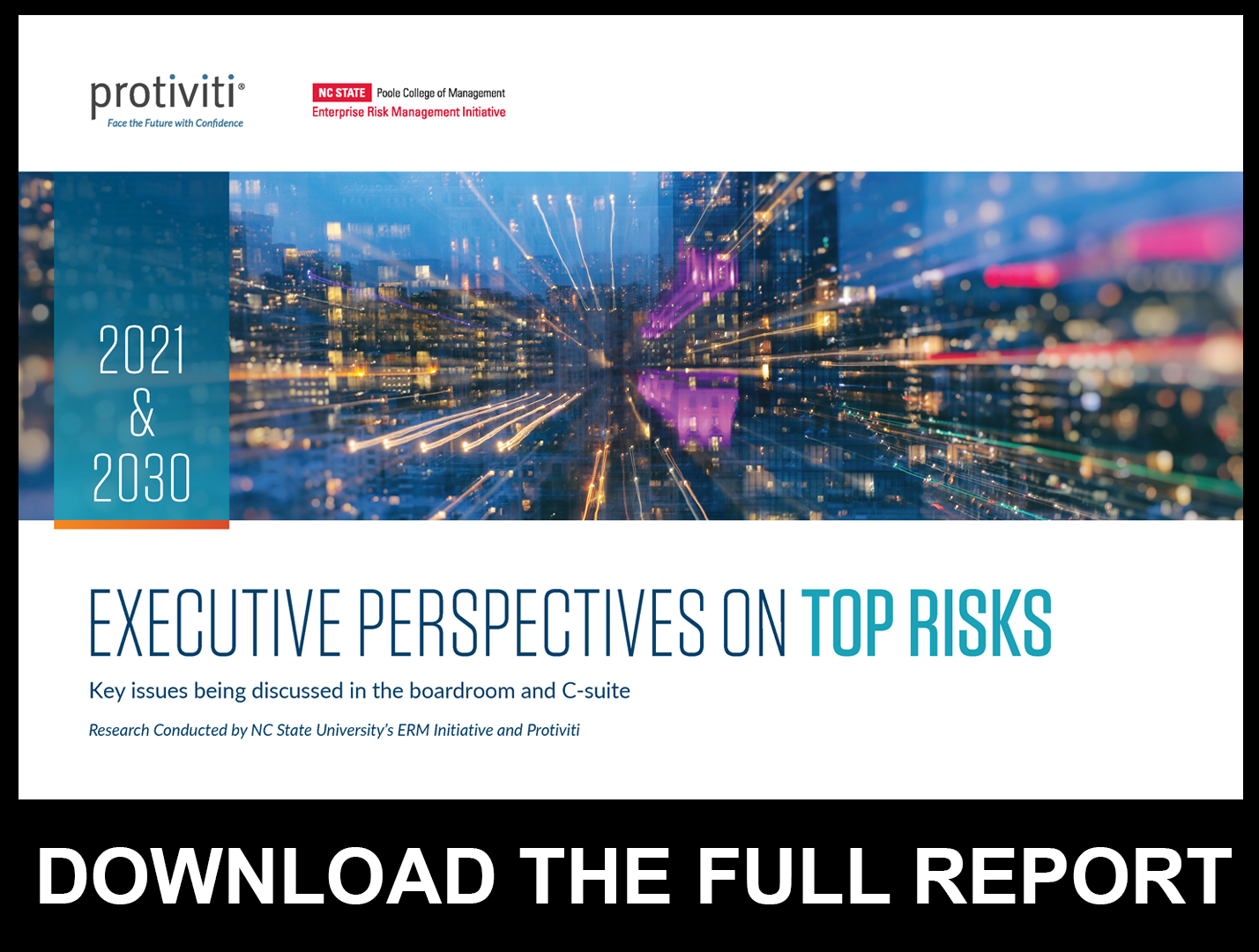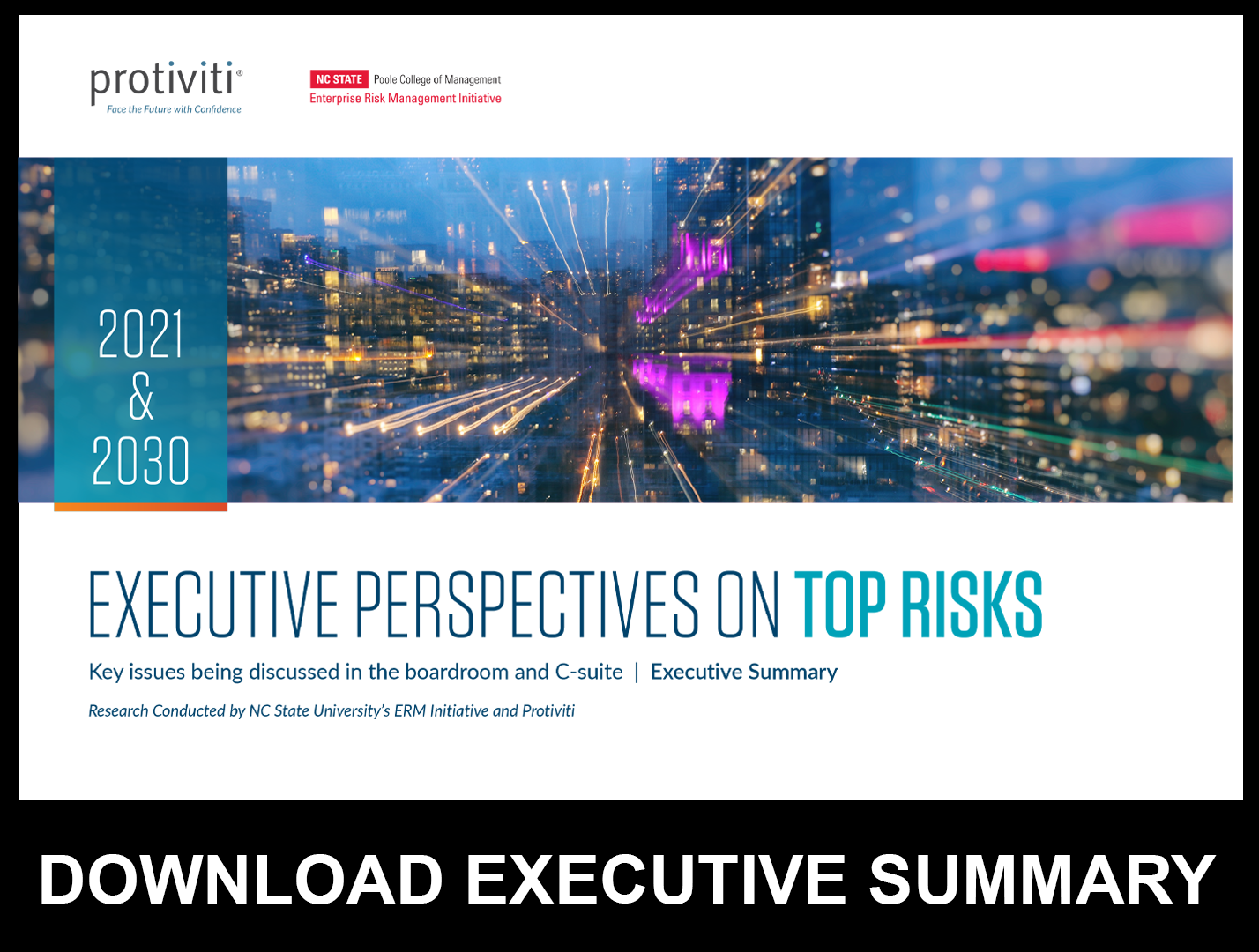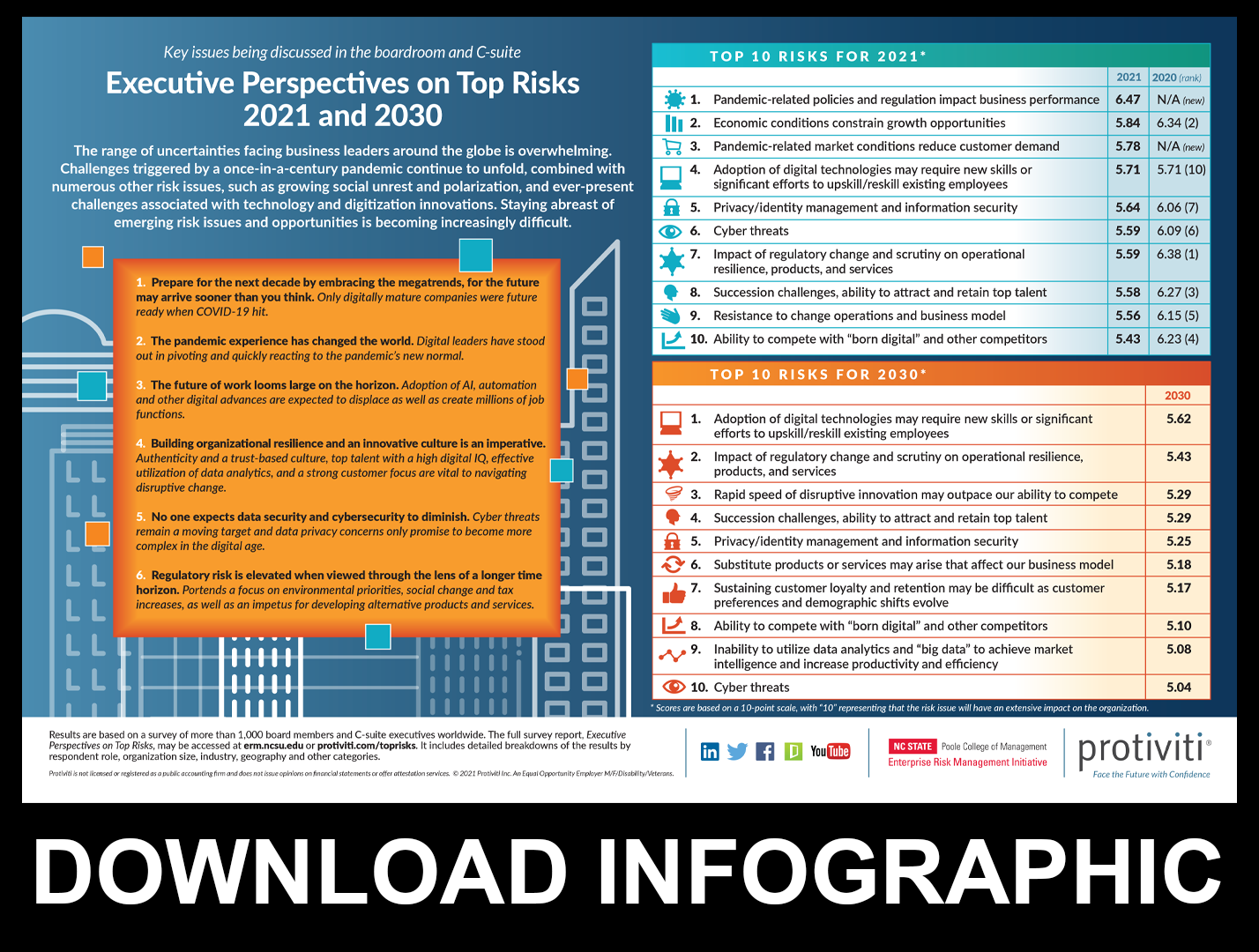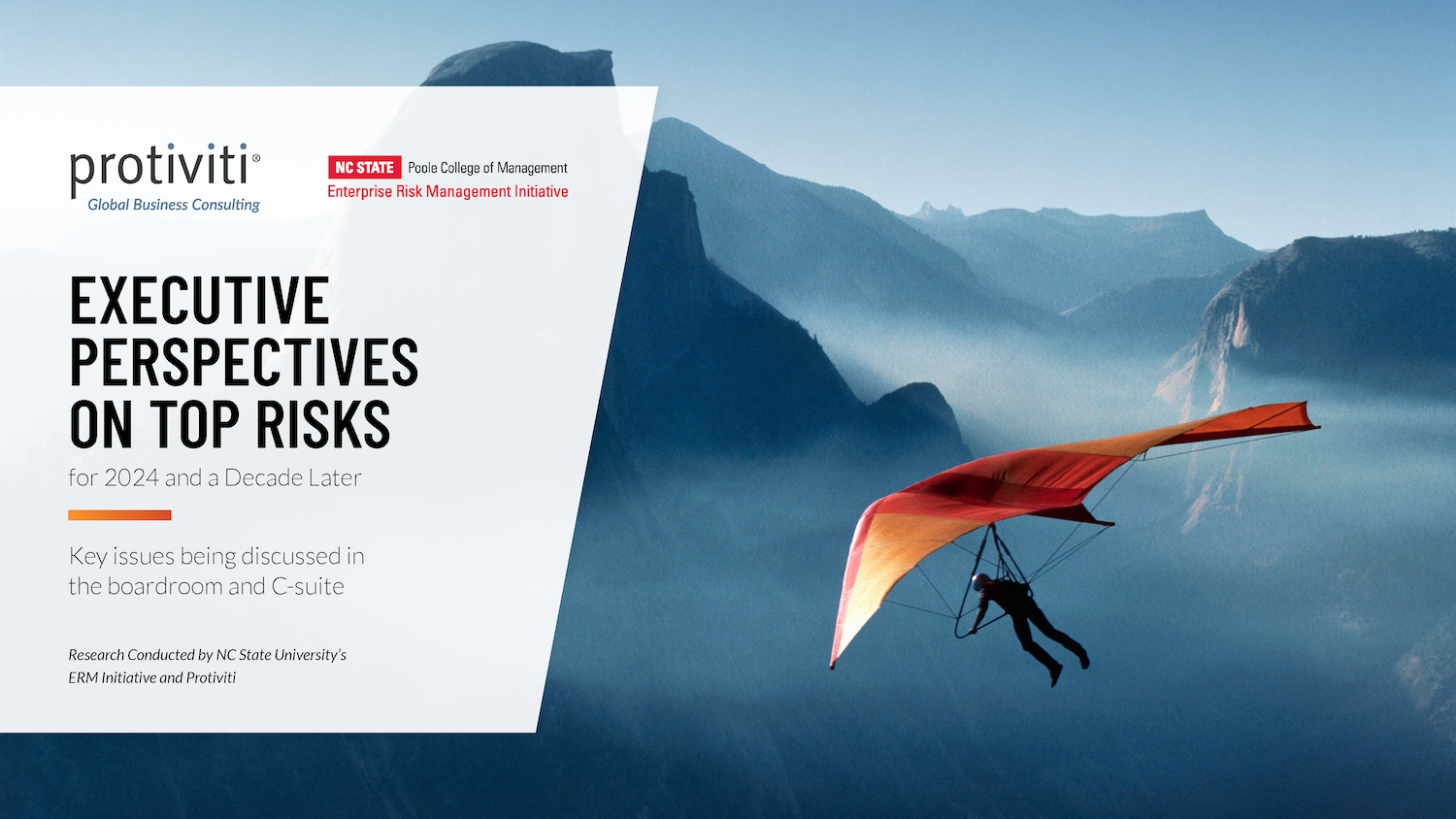REPORT: Executive Perspectives on Top Risks for 2021 & 2030
REPORT: Executive Perspectives on Top Risks for 2021 & 2030
The ERM Initiative in the Poole College of Management at North Carolina State University, in conjunction with global consulting firm Protiviti, annually surveys boards of directors and C-suite executives about risks on the horizon for the upcoming year. This report, 2021 & 2030 Executive Perspectives on Top Risks, highlights top risks of immediate concern on the minds of executives for 2021 – and for the long-term – 2030.
Risks Tied to Pandemic Have Changed the World
The survey report – the ninth annual such research report – assesses the concerns of 1,081 board members and executives globally, across a variety of industries. Of top concern on the minds of this year’s respondents is the impact to their organizations from the evolving government policies and regulations imposed to address public health, social distancing, and crowd limits. Tied to that concern is worry about the overall economy, including high unemployment, government stimulus, and the ability to do business. The rapid shift to a virtual economy has forced organizations to adjust their core business model in how they deliver products and services, with many executives concerned about the lingering impact that will have on customer demand.
Challenges to Adopt Technologies and Emerging Innovations
In addition to immediate concerns about the pandemic-triggered risks, Boards and C-suite leaders across the globe are most concerned about the escalating competition for specialized talent and the ability of organizations to advance their digital maturity and embrace the transformative opportunities of technology. The rush for talent that can help organizations compete with digitally savvy entities has made the acquisition of talent and succession planning challenges of top concern. And, executives are focused on whether business leaders have the vision and ability to push beyond a resistance to change from what used to seem “normal” to the “next new normal.”
Business Resiliency Can’t Be Ignored
COVID-19 has changed the core operations of almost all businesses, requiring the embrace of new ways of doing business in a virtual world. As organizations rush to ensure their organizations can operate and thrive, many of their leaders are concerned that those rapid alterations to their businesses may be making it more difficult for them to ensure privacy/identity management at levels now expected by key stakeholders and regulators, and they are concerned that their organizations may not be sufficiently prepared to manage cyber threats that have the potential to significantly disrupt core operations or damage brand in both 2021 and 2030.
Risk Differences Exist Across Various Characteristics of Respondents and Organizations
Like our prior studies, we conduct a number of analyses across different subsets of our sample, including analyses across sizes and types (i.e., publicly traded, private for-profit and not-profit/governmental) of organizations, industries and geography, and we are able to analyze the findings across different types of respondents (i.e., board members, CEOs, CFOs, etc.) Here are a few key insights from those sub-analyses:
- While risks triggered by the ongoing pandemic are top of mind for executives of all sizes of organizations, larger organizations are more concerned about attracting talent to adopt digital technologies while smaller firms are more focused on risks about succession planning.
- There are noticeable differences in views about the significance of risks in 2021 across different executive positions, with board members and CEOs only rating four of the 36 risks as “Significant Impact” risks as compared to chief information/chief technology officers and chief strategy/chief innovation officers who rate 25 and 22 risks at that level, respectively, among the 36 risks examined.
- There is a mixed contrast in perspectives across industry groups about specific risk concerns, with the Healthcare industry group indicating the highest level of risk concern for 2021.
- While respondents across all eight geographic regions agree that the overall magnitude and severity of risks are at the “Significant Impact” level, there is noticeable variation about which specific risks make the top five list of risks across each of those eight geographic regions.
- Not-for-profit and governmental organizations perceive the level of risk to be much higher for 2021 relative to publicly traded and private/for-profit enterprises.
The Top 10 Risks for 2021
Survey respondents were asked to rate 36 different risks involving macroeconomic, strategic, and operational issues. Following are the top 10 risks identified in the “2021 & 2030 Executive Perspectives on Top Risks” report:
- Government policies to address the pandemic may lead to regulations and protocols that significantly impact how we do business and our performance.
- Increased concern among most executives about economic conditions may restrict growth prospects in relevant markets, but with some exceptions.
- Market conditions and shifts in consumer behavior resulting from the pandemic may continue to impact customer demand.
- The adoption of digital technologies in transforming the business require new skills that the organization may not be able to attract or retain.
- Privacy and identity management may require significant resources for us.
- Our organization may not be adequately prepared to manage cyber threats.
- Regulatory change and heightened regulatory scrutiny may impact operational resilience and production and delivery of products and services.
- Succession challenges and talent acquisition and retention may limit our ability to achieve objectives.
- Resistance to change in our organization’s culture may restrict us from needed changes to the business model.
- Existing operations, legacy infrastructure and digital capabilities may limit our ability to adjust to “born digital” or compete with superior performing competitors.
Overview of Report
The 2021 & 2030 Executive Perspectives on Top Risks survey was conducted in the fall of 2020 after the November national elections in the United States of America, and respondents represent organizations across the globe in the public and private sectors. About half of respondents’ organizations have annual revenues of $1 billion or more.
Additional Resources Available to Learn More
In addition to the full report, 2021 & 2030 Executive Perspectives on Top Risks report from Protiviti and North Carolina State University, you may also download an Executive Summary and Infographic at the links below. A podcast highlighting the key results is also provided below.
Webinar Recording | February 24, 2021
Listen to the recording of the complimentary 60-minute webinar exploring the implications of the survey results held on Wednesday, February 24 at 2:00 p.m. EST, featuring NC State’s Dr. Beasley and Protiviti’s Jim DeLoach and Pat Scott.
Partnership Between
Original Article Source: “2021 & 2030 Executive Perspectives on Top Risks”, Mark S. Beasley and Bruce C. Branson, Protiviti, 2021
- Categories:
- Types:







